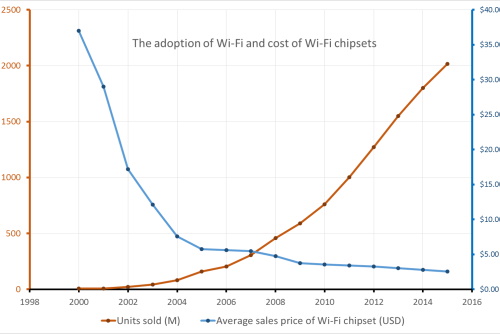When market introduction requires cooperation with your competitors
Some products are meaningful only when used together with companion products – DVD discs and DVD video players, for example, or Wi-Fi access points and Wi-Fi capable laptops.
What is the point of buying a DVD player if you can’t buy a DVD disc?
For such products, a successful market introduction often requires cooperation between companies from different industries. Going alone is risky when you need to develop and market products that are as different as a DVD disc and a DVD player.
The most important deliverable of such a cooperation is a technical document: the specification of the interface between the product and its companion product. Products that implement this specification will work seamlessly together with products made by other companies.
This type of cooperation is a form of ‘joint development’ that most companies will be familiar with. The usual contracts for joint development, however, are insufficient when you are not only working with partners but your competitors are invited to participate as well.
Network effect makes product introduction difficult
Cooperation with competitors may be necessary when the new product is subject to a strong network effect. The DVD disc is classic example of a product with a strong network effect because consumers will only buy a DVD player when they have a lot of choice in DVD discs. And movie publishers will invest in publishing DVD discs only when a large number of of consumers own a DVD player. This is often referred to as a ‘chicken and egg problem’.
Products with a strong network effect are notoriously difficult to introduce. Adoption is slow compared with other products.
 The example of Wi-Fi shows how long it can take to develop an interface specification, and how long it takes to reach widespread adoption:
The example of Wi-Fi shows how long it can take to develop an interface specification, and how long it takes to reach widespread adoption:
1990: IEEE 802.11 working group established – work on the Wi-Fi specification begins.
1997: First version of the Wi-Fi specification approved.
2003/2004: Installed base reaches 100 million units.
Source: ABI Research
Organizing the cooperation between competitors
The development of interface specifications such as DVD and Wi-Fi require a suitable environment for meetings and the exchange of ideas. When the number of participating companies grows, and definitely when competitors participate, it is essential to create a charter for the cooperation with rules for confidentiality, decision making (voting), intellectual property (patents), and cost sharing (membership fees).
The choice of rules determine the efficiency of specification development. It is easy to get stuck in fighting between companies that want to embed their preferred technology. If not properly managed, the atmosphere between the participants is easily poisoned and progress slows down.
With a suitable charter, and by managing the group of companies with respect for the different business interests, the cooperation can be efficient and deliver results quickly. And the cooperation is even more rewarding when the cultural differences between companies and between individuals are understood and respected.
More examples
25 January 2022: Article in The Register “IPv6 is built to be better, but that’s not the route to success” explains why IPv6 has still not replaced IPv4. The essence: IPv6 is incompatible with IPV4 and a work-around (NAT) was created that solved the main problem that IPv6 was meant to solve (limitation on the number of available IP addresses).
Further reading
The article “Managing Competition Between Standards” discusses how the manage the development of competing standards within a single organization.
The article “Proprietary or open standard? A case study” shows how network effects create winner-takes-all dynamics.
The article “Why Startups Fail” will help you understand that it risky for startups to target markets that are subject to network effects.
The article “The effect of patent royalties on the adoption of standards” analyses the impact of cost on adoption of products that are subject to strong network effects.




